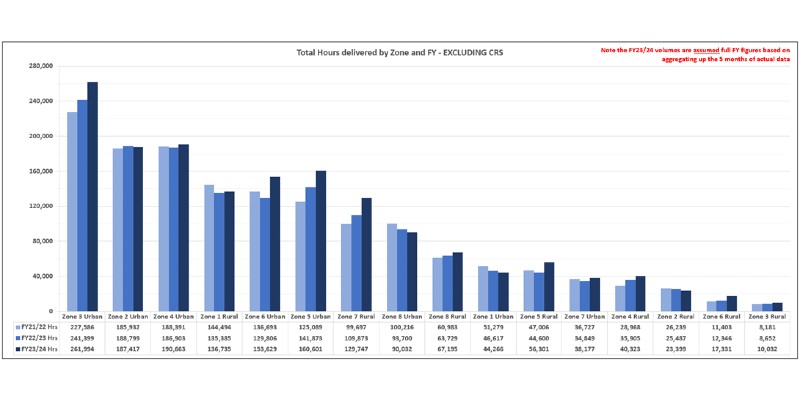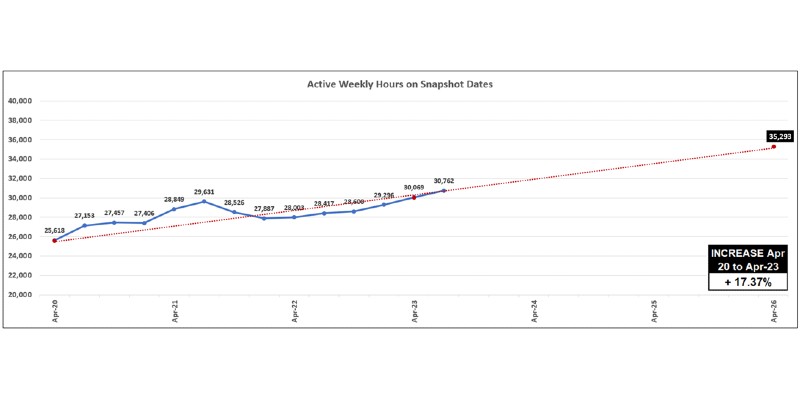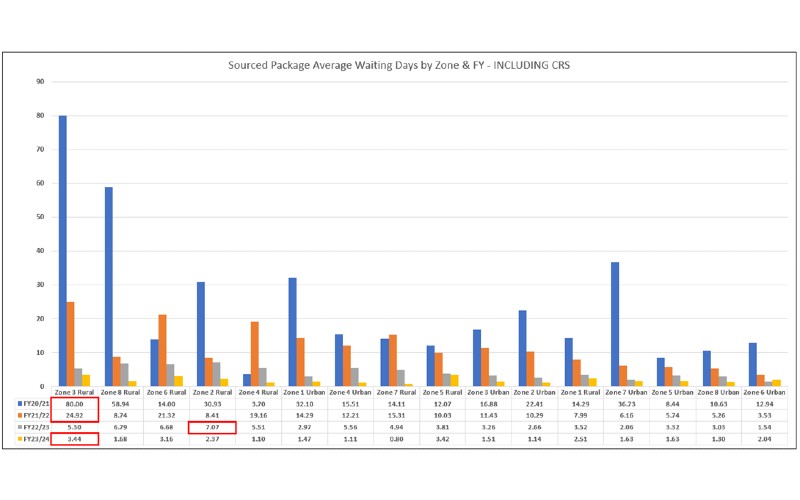Current capacity and forecasted demand
Current domiciliary care provision
There are 21 providers on the zonal contract and 29 registered spot providers with the majority of these registered in Warwickshire and the remaining based in the wider Midlands including Coventry, Leicestershire and Solihull. Together they help to provide a total of 1.5m hours of care in 2022/23 which is expected to increase to approximately 1.6m hours in 2023/24.
Number of hours delivered in each zone
During the financial year 2022/23, Zone 3 urban (Bedworth, Attleborough, Bulkington, Exhall), recorded the highest delivered hours with 241,399 hours, which is 21.8% higher than the next highest zone. Urban zones accounted for the top four zones in terms of delivered hours, representing 50.5% of the total hours delivered. The bottom seven zones had fewer delivered hours overall than Zone 3 urban financial year 2022/23. We can also see that total hours delivered increased by 7.2% from financial year 20222/23 to financial year 23/24 YTD which is an increase from the 1.4% increase from financial year 2021/22 to financial year 2022/23. Please note the total number of hours does not include Community Recovery Service hours for financial year 2023/24.

Future demand
The graph below shows the total number of hours for our domiciliary care service users in Warwickshire between 2020 to 2023 and the projected growth thereafter to 2026. Over the years, there have been significant change in the total number of domiciliary care hours. In April 2020, there were 25,618 hours of care provided. By April 2023, this number increased by 17% to 28,849 hours, indicating a growing demand for in-home care services. It is projected that in April 2026, the total number of hours will rise further to 35,293, representing a 38% increase compared to April 2020.
These percentage growth figures suggest a rising need for domiciliary care services in Warwickshire. Several factors may contribute to this trend, including a growing aging population and evolving healthcare requirements.
COVID-19 has further complicated the forecasting of future trends. The pandemic caused significant disruptions in healthcare service delivery. The dynamic nature of the pandemic and its impact on healthcare needs has made it challenging to predict future trends accurately.
As a result, understanding and forecasting the future demand for domiciliary care in Warwickshire necessitates a comprehensive approach, considering both pre-pandemic and post-pandemic trends, and collaborating with healthcare providers and domiciliary care providers to gather valuable insights into these evolving demands.

Time to source packages of care
The graph below illustrates the average sourcing times by financial year for comparative analysis. It’s important to recognise that the zone with the longest average sourcing time may change between financial years. What is apparent is the substantial contrast in sourcing times between urban and rural zones, highlighting the challenges faced when sourcing care packages in rural areas.
It’s encouraging to note that the gap between urban and rural sourcing times has notably narrowed, however, we remain attentive to the potential issues providers encounter when sourcing packages in specific rural zones.
The data highlights a positive trajectory of decreasing average sourcing times across financial years, indicating enhanced efficiency in the sourcing process, along with the requirement to source CRS packages of care with 24 hours. While most zones have shown significant reductions in average sourcing times, Zone 6 rural presents an opportunity for further enhancements to optimise sourcing efficiency in financial year 2023/24.
